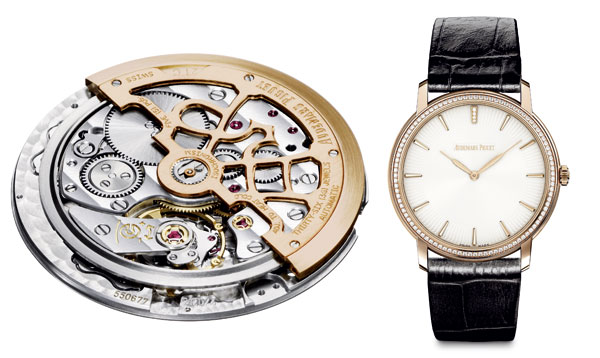
Exterior :
Although the technical constraints are more specific than one might imagine, producing an extra-thin watch case does not involve any major difficulties. The true challenge relates more to the artistic work of the designers. Managing to simplify a design in order to sublimate essentials is paradoxically the toughest exercise facing a designer. The case-dial-bracelet ensemble of this Jules Audemars is clearly a success in terms of proportions, and especially of materials and finishes. The model entrusted to us for this test bench was in pink gold with a bezel set with round diamonds. Powered by a selfwinding movement, this new reference is the epitome of slenderness. That in itself already represents an impressive performance, but it is in fact the interaction of this diminutive thickness with the other dimensions that achieves such a consistent overall effect. The diameter of the case is just 41 mm, which seems fairly small by current standards. However, this size looks more like 43 mm in proportion to the rest, while maintaining dimensions suited to universal usage (men, women, Europe, Asia, etc.). The lugs are small and discreet, contributing to the elegance of this model as well as broadening the range of potential purchasers. The slim bezel provides a modest space for gemsetting. It was a wise choice to have focused on elegance – a quality one naturally expects from such a watch – rather than merely on the marketable value of a “bling-type” adornment. The silver-toned dial is partially guilloché-worked and lends a final touch of natural refinement to this watch, along with its 12 o’clock numeral set with three virtually invisible diamonds that nonetheless create a remarkable effect.
Movement :
A movement well known to collectors and connoisseurs of Fine Watchmaking, the Calibre 2120 found in this Jules Audemars single-handedly sums up the competencies developed by the artisans of the Vallée de Joux and also brings us back to the Royal Oak that we mentioned in the introduction. This movement was originally developed in 1967 by a prestigious manufacturer in the region (it’s a pretty open secret) and was formerly used by two of the largest Geneva-based brands. All three indeed contributed to funding its development. This was also the calibre chosen to power the first Royal Oak in 1972, the famous “Jumbo”. The very fact that this mere 2.45 mm thick movement is enough to drive displays of the hours and minutes with bi-directional automatic winding and an optional date disc (Cal. 2121) without enlarging the size is already an achievement in itself. While it is definitely not a record-breaker for slimness in its category, a careful consideration of the quality, the intelligence and the aesthetic appeal of its conception confirms that it deserves its title as a legend. The automatic winding system sums up the scope of the accomplishment. The full inertia of the 21K gold oscillating weight is offset to the outer rim, thereby making the most of the thin nature of the movement. This rotor is screwed to a peripheral crown, thus ensuring the rigidity and flatness of the mechanism – of which the efficiency would otherwise exceed the acceptable mechanical limits – and which is mounted on four vertical synthetic corundum runners. The openworking and engraving on this oscillating weight convey the splendour of the AP signature. The regulating organ would also deserve an article in its own right, since it sums up the best of the finest watchmaking stakeholders involved in its conception. Dynamic variable-inertia for enhanced isochronism, matched by exemplary finishing: Calibre 2120 is quite simply the best choice.
Tests :
After such enthusiastic praise, Calibre 2120 must be viewed within the context of its category of true extra-thin movements in order to avoid a state of premature over-excitement among watchmaking geeks. Its chronometric or precision performances are not a match for its high-powered counterparts built without any regard for size. Moreover, this calibre does not drive a seconds display – a fact that necessarily implies a higher tolerance threshold. Nonetheless, it delivers results that are surprising in terms of their regularity. Once the angle of lift has been duly noted as an unusual 56°, measurements can begin. The amplitude measured fell within a range of 271° to 286° in the five positions when fully wound. At the same time, the rates were measured at between -2 and +5 seconds/day. After 24 hours of operation, the rates remained closely grouped between 0 and + 7 seconds/day, while the amplitudes had dropped 8° to 10°. Although the manufacturer recommends manual activation of the winding when the spring is completely discharged, the automatic winding is a pure marvel – a perfect compromise between smoothness efficiency. Since elegance is its leitmotif, we will not refer to wearer comfort but instead of wearing awareness – in this case just enough to savour its discreet refinement.
Conclusion :
The choice of an ultra-classic watch such as this Jules Audemars is above all a question of personal feelings. We strongly recommend following your own instinct in this respect. Nonetheless, if the heart does indeed lean towards this watch, we can safely state that it is one of the finest guarantees of satisfaction in its category. Its stunning movement is one of its major assets, and it is worth noting that it has had 50 years of loyal service behind it to demonstrate that, in the hands of a meticulous watchmaker, it can certainly boast historical reliability and durability. Audemars Piguet deserves due respect and encouragement for this fine embodiment of its expertise. Let’s hope that the Manufacture in Le Brassus will pursue this path in enabling us to rediscover some of its collections endowed with such legitimate historical importance.






